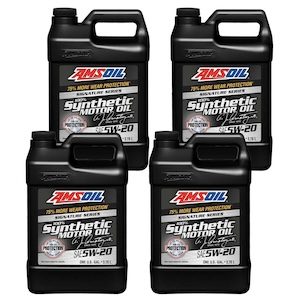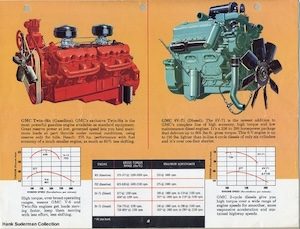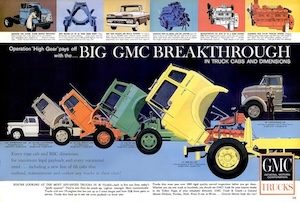By Greg Zyla —
Modern-day oil change intervals
Q: What would be better or best concerning the interval between oil changes using 5W30 synthetic oil versus regular 10W30 or 10W40 oil? My vehicle is a 1996 Ford Ranger with 143,000 miles on it. It has a 2.3-liter engine with a 5-speed manual.
Normally, I change my oil every three months when driving to work roundtrip daily. However, now I’m retired and drive less than 3,000 miles a year. I use Motorcraft Synthetic and have used Havoline 10W30 conventional oil in the past.
Thank you, Tom Yearly, Goehner, Nebraska.

AMSOIL was the first fully synthetic oil made available to consumers in 1971. Mobil 1 followed in 1974. (AMSOIL)
A: Tom, you’ve taken great care of your Ford Ranger over the years, and with 143K on the odometer, you can hopefully expect many more trouble-free miles ahead.
To answer your question, when I look back at some of my answers back in the 1990s on oil changes, it becomes apparent that oil and oil change intervals have changed significantly over the years, thanks to advancements in engine technology and oil formulations.
Gone are the days when a standard oil change occurred every 3,000 miles or three months. Modern vehicles and synthetic oils have extended these intervals, but it is crucial to follow the manufacturer’s recommendations to ensure your engine stays in top condition.
As for oils, numerous synthetics now feature European full synthetic zero and 5W weight blends that are used on numerous modern American cars and trucks. I do use synthetics in my cars as they are superior in very wintry weather conditions, especially on that very first, sub-zero start in the morning. Bottom line? Things have come a long way since the first synthetic motor oil to meet API service requirements in 1971, that being AMSOIL. Mobil 1 arrived in 1974. Remember that modern engines now utilize ultra-thin bearing tolerances that call for specific zero and 5w Weight oils or, if not used, engine problems can occur.
To focus on your questions, several factors influence how often you should change your oil:
1. Vehicle Age and Type: Older cars typically require more frequent oil changes compared to newer models. Older engines may not be as efficient at maintaining oil quality.
2. Type of Oil: Full-synthetic oils generally last longer than conventional or synthetic-blend oils. Full-synthetic oils can often go up to 15,000 miles between changes.
3. Driving Conditions: Severe driving conditions, such as frequent short trips, extreme temperatures, stop-and-go traffic, or towing heavy loads, can accelerate oil degradation and necessitate more frequent changes.
4. Oil Life Monitoring Systems: Many modern vehicles come equipped with oil-life monitoring systems that alert you when an oil change is needed based on actual driving conditions.
Recommended Oil Change Intervals
1. Older Cars: Typically, older cars require oil changes every 3,000 miles or three months, depending on driving conditions. If your car falls under the “severe service” category, you might need to follow a more rigorous schedule.
2. Newer Cars: Most newer cars recommend oil changes every 5,000 to 7,500 miles. Some vehicles with full-synthetic oil can go up to 10,000 to 15,000 miles between changes.
3. Time-Based Intervals: Some older vehicles have time-based intervals, such as every three months or six months, regardless of mileage. This is because oil naturally degrades over time, especially when exposed to moisture and contaminants1.
4. Mileage-Based Intervals: Modern vehicles often have mileage-based intervals, such as every 5,000 miles or more. It’s essential to follow these guidelines to ensure optimal engine performance.
Importance of Following Manufacturer Recommendations
5. It’s crucial to follow the oil change intervals specified in your vehicle’s owner’s manual. Using the correct type of oil and adhering to the recommended schedule helps maintain engine efficiency, prolongs engine life, and ensures your vehicle remains in good working condition.
Changing Oil Too Frequently
6. Changing your oil more frequently than necessary can lead to unnecessary waste and environmental impact. It’s important to strike a balance between maintaining your engine and being mindful of environmental sustainability.
Conclusion
Oil change intervals have become more flexible with advancements in technology and oil formulations. However, it is essential to follow the manufacturer’s recommendations based on your vehicle’s age, type of oil, and driving conditions. Regular oil changes are crucial for maintaining engine health and ensuring that your vehicle runs smoothly.
Whether it is synthetic or normal paraffin-based oil like the 10W30 Havoline, fewer oil changes are in your future. Thanks for your question. I also want to thank AutoZone, AAA, and auto.howstuffworks.com for the latest info on oil technology.

Here’s an ad from 1960 featuring the lineup of GMC trucks and their new engines, including the first-ever V6 truck engine and a powerful V12 built for semi-trailer and tractor-trailer applications. (Courtesy GMC Trucks)
Reader recalls GMC’s V12 engine from 1960
Q: Hi Greg. My friends and I have been discussing V6 truck engines, and I remember a GMC V12 cylinder engine that was available in 1960 in big trucks. Can you please tell us about this engine, and that there definitely was a V12 available? Thanks much. Jimmy L., Bloomsburg, Pa.
A: Jimmy, I’m happy to oblige. You are correct that GMC Trucks designed and made available a unique V12 engine that comprised two V6 GMC engines united by a sole engine block and crankshaft. It first became available in 1960.
This engine comprised the main parts of two 351-inch V6 engines that appeared that year for use in pickups and heavy-duty trucks. Noteworthy is that GMC was the first manufacturer to offer a V6 in the truck line (pickups included) and it used its 351-inch V6 design for its new V12 engine.
The V12 was available through 1965 in the heavy-duty truck line and topped out at 702 cubic inches (two times 351) of brute strength and torque. The engine was officially called the “Twin Six V12” by the marketing department. The engine developed 275 horses and 630 lb. ft. of torque from 1600 to 1900 rpm and was able to climb hills better than a diesel engine with minimal downshifting according to reports from General Motors.
Notable is that even in the recent past, both Volkswagen and Audi released similar concept engines, as both of their 12-cylinder models applied a parallel engine ideology. However, the major difference between GMC in the 1960s and VW/Audi of the 2000 decade is that Volkswagen (with its Phaeton) and Audi (with its Audi W12) mounted their V6 engines side by side in a “W” design attached to a common transmission crankcase instead of lengthwise.
Thus, even though it may appear that GMC’s V12 is two mated V6 engines, it is not so thanks to the shared single block and four-foot-long crankshaft.
Today, the chances of finding one in a wrecking yard are next to impossible as enthusiasts have snapped them up and rebuilt them. One of the nation’s top rebuilders and developers of the GMC V12, namely www.thunderv12.com, has a website I know you’ll enjoy. It’s loaded with interesting history on this often forgotten GMC engine, along with photos and info galore. Thunder V12 rebuilds these engines to modern-day specifications, using quality parts throughout, improved oiling and cooling systems, modern ignition systems, and even has ARP Rod Bolts and Fasteners, a top name in the aftermarket performance industry, design, and the supply all of the connecting bolts, fasteners, and studs used in the assembly.
GMC heralded its V12 back then as an engine that would easily run over 200,000 miles, which at that time was usually reserved for the ultimate of semi and tractor trailer type diesel engines instead of a GMC-built gasoline V12.
Thanks for your letter and best wishes for the new year.
(Greg Zyla is a syndicated auto columnist who welcomes reader questions on collector cars, auto nostalgia or motorsports at extramile_2000@yahoo.com or greg@gregzyla.com.)



Be the first to comment on "Cars We Remember / Collector Car Corner; Reader seeks oil change information for his 1996 Ford Ranger; remembering the GMC V-12"